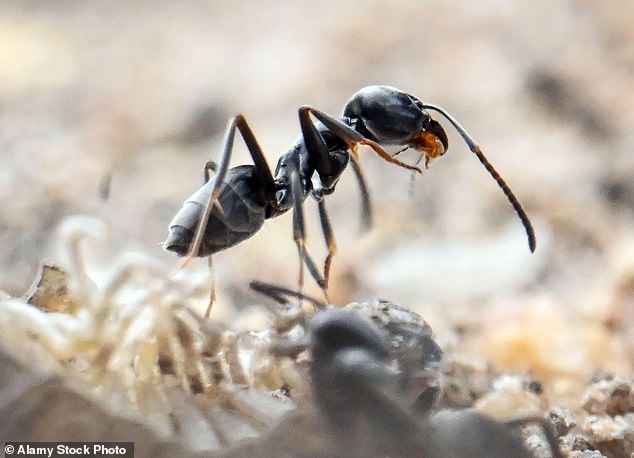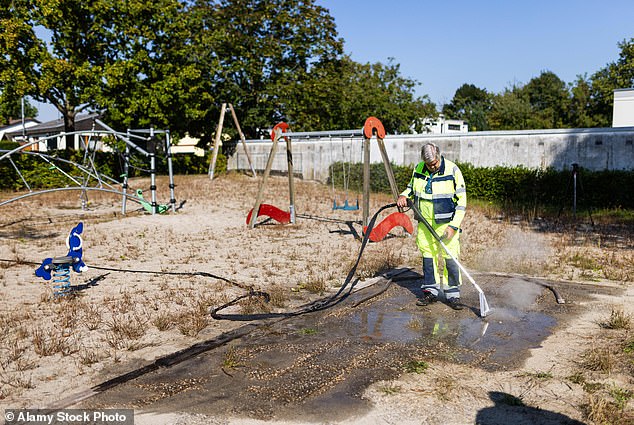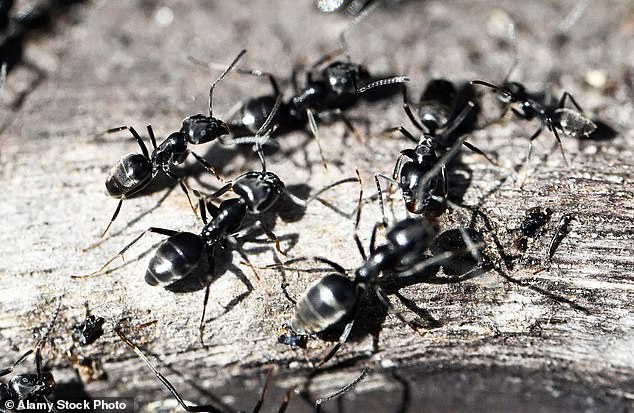Tunnelling with the fervour of an invading army, the millions of insects displace so much earth that pavements above them subside, walls collapse and even tombstones begin to topple.
Elsewhere they turn their attention to electrical cables, chomping through them – causing phone networks to go down and lights to flicker before power fails altogether.
It sounds like something out of a low-budget horror film. But the scenario described happened in the south-western German city of Kehl in 2017, and the voracious little creatures in question were not monsters from space but the ants which have also been menacing other northern European countries of late.
Their scientific name is Tapinoma magnum but the invasive species are more commonly described as ‘super-ants’, a name which hints at the disturbing characteristics which set them apart from the black ants we see in our homes and gardens.
The latter’s arrival in warmer weather has long been as familiar a part of the British summer as village fetes and burnt sausages on a barbecue. Now it seems their far more aggressive cousins are getting closer to British towns and cities.
Indeed, as the Mail discovered this week, they are already here, albeit in rural areas where they have yet to unleash their full potential for harm.
But it can only be a matter of time before they reach more populated parts, a seemingly unstoppable force despite being the same size as black ants and virtually identical in appearance.
One way to differentiate them is that, unlike black ants which tend to move in single file as if queueing for tickets at Wimbledon, super-ants move in conspicuous, very busy columns which are often metres long. And where they go, chaos follows.

Tapinoma magnum ants are an invasive species more commonly described as ‘super-ants’, and it seems they are already in British homes and gardens
Most ant species have only one breeding queen, supported by thousands of sterile workers, and if colonies encounter each other they usually go on the attack. But super-ant groups merge, forming one huge colony of up to five million with multiple queens.
These miniature monarchs are supported workers building nests which sprawl over vast areas and are up to one metre deep.
In recent years they have caused many millions of pounds of damage but they have been a pest since the days of Ancient Rome. Thought to have come to Europe thanks to the trade between the imperial capital and its ‘breadbasket’ countries in North Africa, they likely travelled onwards aboard the potted plants and trees transported throughout the Mediterranean.
And, as such leafy Trojan horses have become more popular throughout Europe in modern times, garden centres have turned into what German entomologist [someone who studies insects] Dr Bernhard Seifert describes as ‘the beach-head’ of the super-ant invasion.
‘The classic plant for them to hitch a ride on is the olive tree,’ he says. ‘But they also like others like banana trees and Phoenix date palms.’ One of the first signs that they had become problematic in Germany came when the ground under a playground in Kehl began sagging because of the huge super-ant nest beneath it. It was closed, but the ants went on to infest wall cavities and buildings, paralysing wifi networks.
‘The ants cause considerable damage, especially in places with predominantly sandy soil,’ says Dr Seifert. ‘In places, you can see kerbs and crazy paving sinking because the material beneath is being carried off.’
In the city of Karlsruhe, 50 miles northeast of Kehl, super-ants disrupted the railway network by burrowing beneath pavements leading to platforms and making them dangerously unstable.
At times they have also terrorised residents by making their homes in private gardens. Far more aggressive than black ants, they respond instantly to the slightest perceived attacks, climbing and biting their way up feet, legs and hands.
Although not poisonous, their bites can irritate the skin; and when the ants are squashed they produce an unpleasant smell likened to that of rancid butter.
It’s small wonder they are an increasing cause of stress.
‘I’ve heard of people who are afraid to go on holiday because they worry that the ants will move into their homes while they are away,’ says German biologist Manfred Verhaagh.
‘Some people have even considered moving house altogether.’

A council worker in the German city of Kehl sprays hot water into an anthill underneath a children’s playground
Verhaagh is one of the experts contributing to a Tapinoma research project at the Natural History Museums of Karlsruhe and Stuttgart. It’s a recognition of the seriousness of the problem which has also caused growing concern in France where farmers have complained about the devastation of crops such as melons and strawberries. These are rich in the honeydew on which the super-ants feast, along with prey including earthworms.
Many such fruits are grown under plastic and it’s thought the warm and humid environment is ideal for super-ants. French scientists have suggested this is one reason they seem to survive best in areas where biodiversity has been weakened.
‘Increasing biodiversity so they have less space to establish themselves is the way forward,’ according to Dr Jean-Luc Mercier, whose research at the University of Tours has revealed the wide area across which the insects have spread, from Toulouse in the south to Brittany in the north.
In Switzerland, they have been plaguing the countryside around Zurich since 2018, recently blocking a £3 billion construction project in the city of Winterthur. There they colonised an area which was the size of ten football fields and covered the exact spot where a rail tunnel was planned.
In the nearby Oetwil an der Limmat region, a colony of super-ants took over an entire 12-acre potato field – equivalent to about seven football pitches – and infested neighbouring homes, including that of local resident Agnes Wirth.
‘There were so many ants, you couldn’t see the floor any more,’ she told Swiss TV channel SRF.
Even that seemed small compared to the problem in Volketswil, on the other side of Zurich: the ants have colonised agricultural land equivalent to the size of 35 football pitches.
But there, and elsewhere, the problem is finding an effective way of eradicating them.
Since each colony can have as many as a thousand queens it is difficult for exterminators to be sure they have destroyed them all. Old remedies such as pouring boiling water down the nest entrance do not work because super-ants have so many holes to come in and out of.
Attempts to kill them with insecticide have failed because the ants apparently recognised it as poisonous and blanketed it with soil to keep their colonies safe.

Unlike black ants native to the UK, which tend to move in single file, super-ants move in conspicuous, very busy columns which can be metres long
While the Department for Environment, Food & Rural Affairs has said it ‘remains vigilant’ to the threat, it is, terrifyingly, already too late to stop the super-ants coming to the UK.
This week, John Paul, an amateur entomologist based in Oxford, told the Mail he had previously come across populations of the super-ants in two locations. ‘One was at a plant nursery in West Sussex back in 2008 and the other was running along the base of a granite wall on the Isles of Scilly in 2021,’ he said.
He believes the former has died out, perhaps eradicated by the bitter winter of 2009-10, the coldest for more than 30 years. But the latter was still there when he returned this May.
He says it’s probable they are elsewhere, too, but haven’t yet caused the havoc suffered by our European neighbours.
That could happen soon according to the British Pest Control Association (BPCA) which suggests that climate change may be playing a role in helping these ants survive further north than previously possible.
‘Warmer winters and longer summers in the UK potentially makes colonisation more likely over time,’ says the BPCA’s technical manager Niall Gallagher.
For now, the assumption is that the queens can only move from one place to another with inadvertent human assistance. But the experience of European countries suggests it may not be long before unsuspecting gardeners help them reach urban areas.
Until that happens, you might want to take a kinder look at the black ants sneaking towards your biscuit tin.












